Apple's iPhone 4: Thoroughly Reviewed
by Brian Klug & Anand Lal Shimpi on June 30, 2010 4:06 AM EST- Posted in
- Smartphones
- Apple
- iPhone 4
- Gadgets
- Mobile
Camera Usability
It still takes almost two seconds to activate the camera on the 4, which is enough time to miss whatever it is you’re trying to grab a photo of. Thanks to the iOS 4 update however, the shutter is almost instantaneous. The difference appears to be that the photo is committed to memory but not fully written to NAND, whereas before the photo would be written to the Flash before you could take another picture. Power loss in the middle of snapping photos seems pretty rare on a smartphone so the tradeoff, if I’m correct, makes sense.
Apple opted for a lower noise rather than higher resolution sensor in the iPhone 4 and it did pay off. The main camera shoots photos at 2592 x 1936 compared to the EVO 4G’s 3264 x 1952, but the resulting images are far less noisy - particularly in low light situations:
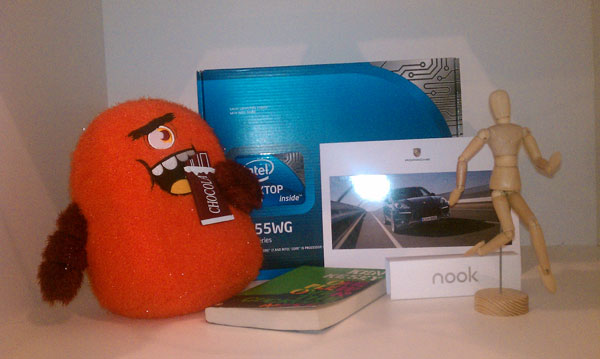
HTC EVO 4G - Low Light
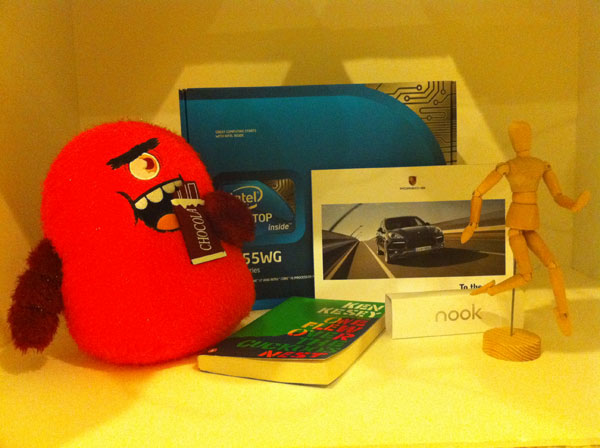
Apple iPhone 4 - Low Light
The 4’s main camera, like the HTC Incredible and EVO 4G, is a decent replacement for a point and shoot if you’re primarily outdoors. You’re still going to get better image quality out of a good point and shoot, but the tradeoff is convenience. The limitations are significant.
Because you rely on the iPhone 4’s software controlled aperture and shutter speed you don’t have the ability to properly expose the image. You have to rely on Apple’s algorithms, which tend to either overexpose outdoors or miscalculate white balance with non-halogen light sources.
This is an example of a photo taken outdoors that’s more washed out than it needs to be:

And many of you picked up on the white balance issue I snuck into our EVO 4G review yesterday:
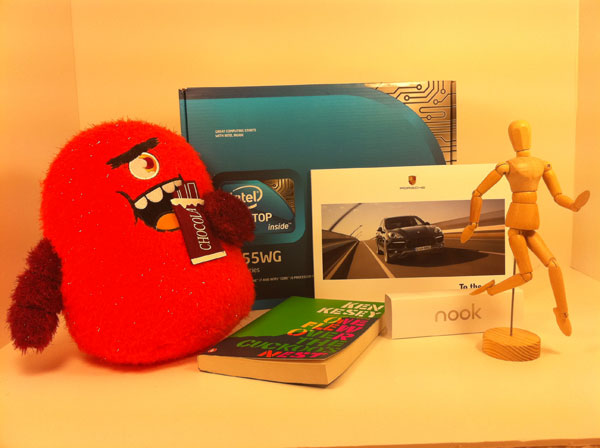
Regardless of where I tapped to focus, I could not get the iPhone 4 to set a proper white balance in our photo box.
While I was watching the screen, the iPhone 4 would alternate between yellow and white for the background color. It seemed to be trying to calculate the white point but was just being thrown off by the type of light. If I timed the shot right I could snag the photo while the iPhone was switching between white balance points:

I also had this problem in my office which uses LED can lights.

This is far more yellow than it should be
While Brian didn't have the same problems I did, Brandon Hill (DailyTech Editor in Chief) did. It seems to be very dependent on the type of lighting you have and even then it seems to vary based on the type of CFLs. And unlike the EVO 4G, there’s no way to manually set a white balance on the 4.
For overall image quality though I have to hand it to Apple, the iPhone 4 does do a better job than the EVO 4G or other phones I’ve used. Take a look at this shot inside my house:
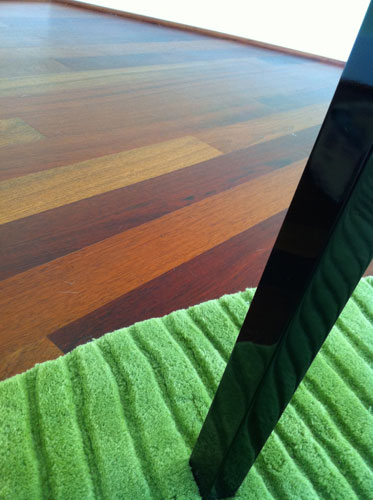
The colors in the iPhone 4 shot are on point. The green is correct, the wooden floor is right and the black is, well, black. The EVO 4G didn’t do so well on this test by comparison:
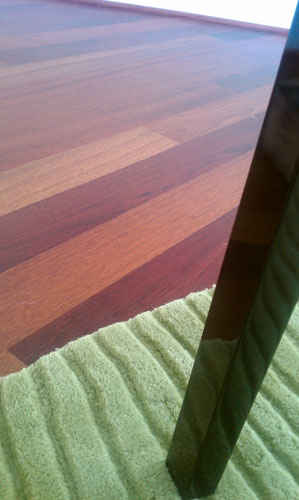
The 4’s camera isn’t perfect, but it does appear to handle colors better than the EVO (with the exception of my white balance issue) and delivers lower noise photos.
Compared to other phones the 4 does similarly well, besting the 5 megapixel camera in the Motorola Droid easily in terms of color reproduction and sharpness. Though the HTC Incredible previously was a top performer alongside the N900, the iPhone 4 makes the Incredible look a bit oversharpened and artificial. Compared to the 3GS, the iPhone 4's improvement is obviously dramatic, as shown in the gallery below.
Video is recorded at 1280x720, in H.264 with AAC mono audio. We measured a bitrate of 1.35 MBps, outclassing all the other smartphones we've tested.
iPhone 4
HTC Droid Incredible
Motorola Droid
Nokia N900
What's interesting is that the iPhone 4 appears to crop the sensor down for video recording, taking the center most 1280x720 pixels instead of scaling down the entire image size. The result is that the focal length for video recording is notably longer than when taking photos.
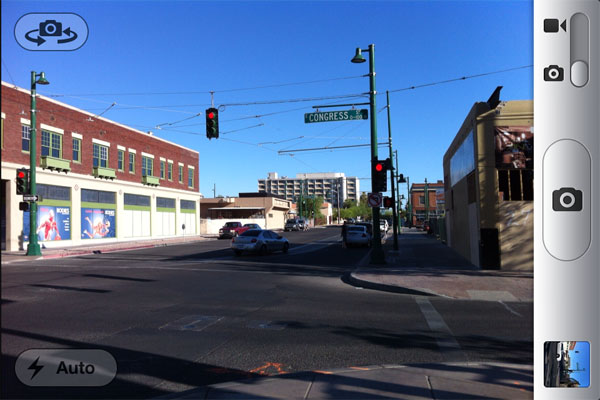
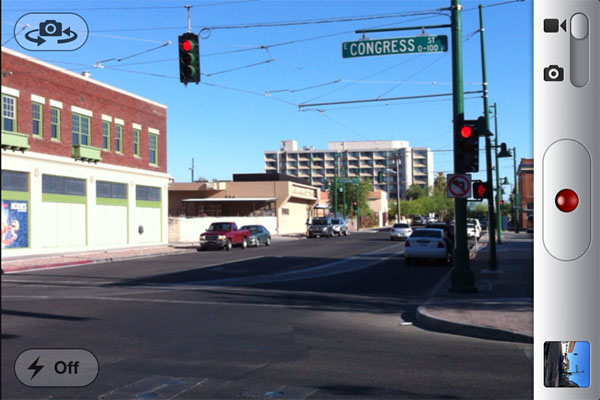
You can see the difference is quite notable standing in the same place. Perhaps the A4 SoC lacks the compute power to apply a scale and encode at the same time, necessitating this crop. Whatever the case, video shot with the iPhone 4 still looks very good at the promised and delivered 30 FPS. Move the camera around enough, and there's still screen door effect from the rolling shutter like any CMOS sensor is going to give you - it's a fundamental problem no phones are going to get around soon. Its also right there in the specifications page for the camera SoC; rolling shutter.
Similarly, iPhone 4 does give you 5x digital zoom, though we still maintain you're better off taking photos at native resolution and messing with them later with better interpolation algorithms.
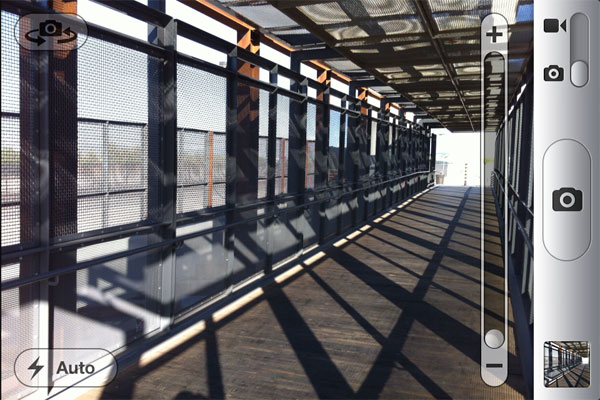
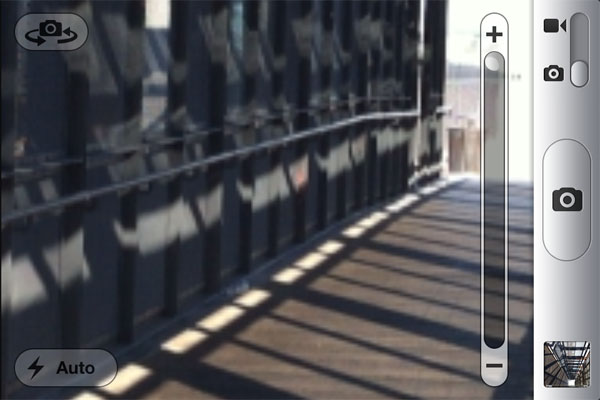






















270 Comments
View All Comments
Lemurion - Friday, July 2, 2010 - link
I was disappointed that you they only compared the iPhone 4 screen to the 800 by 480 AMOLED screens on some of the Android devices. As far as I know, all those devices use the Pentile system, which reduces the crispness of text.I would have really liked to compare the new Apple screen to the Motorola Droid's 266 PPI screen and see how noticeable the difference there was.
Matt Campbell - Friday, July 2, 2010 - link
Nice investigation work on the signal strength. Just wanted to point out that AnandTech is cited in the Apple iPhone 4 software fix story on CNN today. http://www.cnn.com/2010/TECH/mobile/07/02/apple.ip...Bad Bimr - Friday, July 2, 2010 - link
http://www.cnn DOT com/2010/TECH/mobile/07/02/apple.iphone.apology/index.htmlJust like apple, finally admitting a problem, pleasing the fan boys by saying it will be addressed and doing nothing to fix it. I am so glad I never jumped on the apple bandwagon.
fischerm83 - Friday, July 2, 2010 - link
So i was reading various news articles today and saw that apple finally figured out/admitted to what you guys found out earlier this week...*quote*
Now the company says its engineers have made a "stunning" discovery. Reception is poor and calls may be dropped because not only are people holding the phone wrong, but they also think they have a better signal than they do. In the statement, Apple says that it has made a mistake in the formula that calculates the number of bars that display the signal strength on all of its iPhones.
"We were stunned to find that the formula we use to calculate how many bars of signal strength to display is totally wrong," it said in a statement.
*quote*
Full Article:
http://news.cnet.com/8301-30686_3-20009564-266.htm...
Nice work guys, keep up the amazing work!
anandreader - Friday, July 2, 2010 - link
Brian-I'm confused as to what had to happen to get Fieldtest onto the iphone 4. Understood the bit about jailbreaking the iphone3 but didn't understand how that information got transfered to the 4.
Could you elaborate a bit there?
Per Grenerfors - Friday, July 2, 2010 - link
Thanks for the great review, AnandTech.In countries where 3G coverages isn't spotty like a teenagers face, the whole antenna/at&t/verizon debate is just utterly unnecessary.
Apple is the only brand name in tech today that's recognized by the broader public. Their products therefore make a big splash in the media when they hit the market. But the bigger splash you make, the more mud comes floating up from the bottom. Like people complaining with a spec sheet in hand without ever having seen the device in real life. Or just plain old haters. This is the downside to fame. But I'm sure Apple's laughing all the way to the bank.
Stokestack - Friday, July 2, 2010 - link
A case isn't an acceptable workaround for this. I don't buy a thin phone to bulk it up and junk it up with a cheesy case or add-on of any kind.While I'm not planning on getting an iPhone 4, if I had one and wanted to keep it I'd try to spray a coating onto the antenna band. I'd mask the front & back, the buttons, and any seams, then spray with polyurethane or something. While it would be microscopically thin, there's be no direct contact with skin. And really, that's what you said you expected Apple to have done anyway. Let's see if it would work.
Excellent review. The hack to get the numeric signal strength rocks.
Fulle - Friday, July 2, 2010 - link
Thank you for the review. It was useful to be able to look at something that was detailed, and included facts, good and bad, without a ridiculous amount of bias. It's obvious that Anand likes, or at least really wants to like most Apple products, but it was nice that that didn't get in the way of the review.The new iPhone seems to be an OK device that's on par with new Android smartphones in way of hardware... The screen's got 20% higher pixel density than the Droid, but 50% worse contrast ratio, and worse black quality... Java performance is clearly inferior to a Nexus One, but browsing performance is competitive (I'd say good, but I think all handsets have shit browser performance). Its sleak and thin, but it has no hardware qwerty. The 5MP camera produces low noise, but, the white balance is messed up, making it overall inferior to the camera in a Nexus One or HTC Incredible (or Moto Droid, even, IMHO... screwed up over-saturated colors with bad white balance are a big deal to me). Overall, it's an average device when put up against worthy competition (EVO4G, DroidX, HTC Incredible, Nexus One, or even a Moto Droid).
But, that's before you have to deal with the obvious design flaws. Glass panels on both sides? WTF? Uninsulated external antenna? These aren't minor flaws here.
So, overall I'd say that the new iPhone is inferior to at least 6 Android smartphones.... and at first I grin at that... but then I'm disappointed and mad. Apple has helped make the smartphone market the competitive environment it is today, and when they drop the ball like this, it means that other venders don't have to raise the quality of their devices to compete. It's just fortunate that Android has so many hardware OEMs, like HTC, Samsung, and Motorolla, all competing with each other... or else I'd be afraid the only thing the iPhone4 would push in competition is a higher ppi on the screens.
Lets hope this helps push the Cortex-A9 equipped Android's this winter to include higher resolution in their displays... but, man, I'm disappointed with this device.
tgibbs - Friday, July 2, 2010 - link
Does zero dB represent a standard absolute signal strength or is it an arbitrary reference value that will differ for different phones?navderek - Saturday, July 3, 2010 - link
The signal is actually measured in dBm which means it is a reference to 1mW of power.For example -30dBm = 1000 times less that 1mW = 1uW
1 microwatt does not seem like much, but actually this is a very strong signal for the mobile and you would rarely have that much power arriving at your handset from the tower. In good conditions, close to the tower or serving antenna with minimal obstructions you could expect about -50 to -60 dBm (-60dBm = 1nW (nanowatt). The system is designed to deal with such small signals...this is why I laugh when people are worried about cell tower "radiation" when actually 5 min. in the sun is a bazzillion times more radiation than what's coming out of a tower....cellular towers that is, broadcast radio towers or paging systems are another story!
But I digress...to answer your question simply, zero dBm simple equals 1mW.
Zero dBm signifies that there is no difference in ratio from the reference of 1mW.